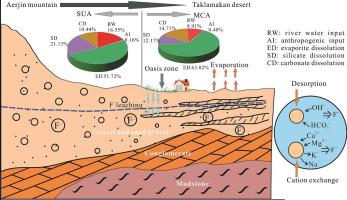Journal of Contaminant Hydrology ( IF 3.6 ) Pub Date : 2023-11-14 , DOI: 10.1016/j.jconhyd.2023.104270 Jun Li 1 , Yinzhu Zhou 2 , Jinlong Zhou 3 , Ying Sun 3 , Yanyan Zeng 3 , Qizhen Ding 3

|
The identification of fluoride (F−) sources and enrichment mechanisms is imperative to understand the multiple fluorine (F) pathways, and further, to control regional diffuse F− contamination in groundwater. However, the factors that control high-F− groundwater are not fully understood in desert climate regions. Hence, a sampling campaign was conducted from 71 desert groundwater sites and six river water sites in the Cherchen River Basin (CRB), northwestern China. This study combined hydrochemical compositions with an optimized forward model, with the aim of determining the potential sources and enrichment mechanisms in F−-contaminated desert groundwater. Approximately 58.46% of the samples had F− concentrations over the national standard of 1.0 mg/L. More severe F− contamination was found in the multi-layered structured confined aquifer (MCA) of the alluvial plain (1.42 ± 1.11 mg/L). The primary contributors of desert groundwater F− were the dissolution of F-bearing minerals containing evaporite (∼58.80%), silicate (∼15.89%), and carbonate (∼12.94%), followed by the river water input (∼12.08%). In contrast, anthropogenic activities (∼0.16%) and precipitation contributed less to desert groundwater F−. The dissolution equilibrium of CaF2 was important for F− enrichment in desert groundwater. Compared with the piedmont plain, intensive evaporation and salinization were more conducive to F− enrichment in the alluvial plain. Under alkaline condition, the dissolutions of evaporite and fluorite allowed extra F− to release into desert groundwater when Ca2+ and Mg2+ were up to oversaturation. Moreover, the desorption of F− was promoted by competitive adsorption of OH− and HCO3−, and the adsorption capacity of F− was weakened by cation exchange of K++Na+ with Ca2++Mg2+. As a result, desert groundwater had a higher concentration of F− in the alluvial plain. Our study provided a comprehensive understanding of multiple F pathways in desert groundwater. This study also highlights the effect of hydrogeochemical background on high-F− desert groundwater.



























 京公网安备 11010802027423号
京公网安备 11010802027423号